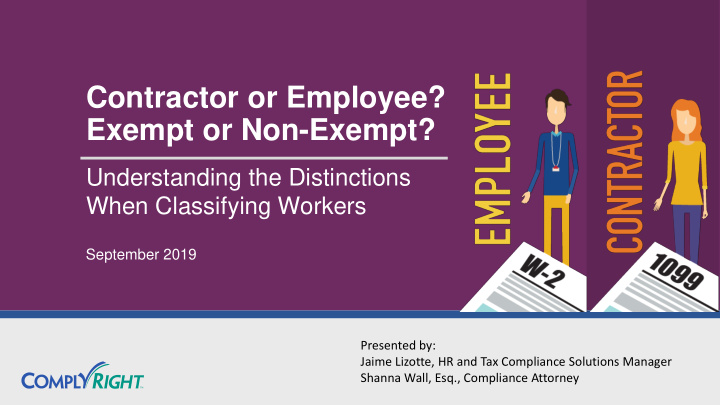



Contractor or Employee? Exempt or Non-Exempt? Understanding the Distinctions When Classifying Workers September 2019 Presented by: Jaime Lizotte, HR and Tax Compliance Solutions Manager Shanna Wall, Esq., Compliance Attorney
What We’ll Cover Today How to protect yourself from costly misclassification mistakes and legal issues Factors that define the worker relationship, according to the IRS and DOL Warning signs that the contractor you’re using is actually an employee under the law What determines exempt vs. non-exempt status Steps to take if a worker is misclassified
Contractor or Employee?
Contractor vs. Employee Very common for businesses to use independent contractors (ICs) to avoid overhead cost But many employers don’t realize there is a distinction under the law Guidelines are complex, and can vary by state It’s estimated 30% of businesses who use ICs misclassify (intentional or not)
What are the Risks? State and federal government agencies are watching Agencies have bias toward treating workers as employees, rather than contractors Harder to collect employment taxes from IC’s ICs are not covered by workers’ comp ICs don’t benefit from most labor law protections Risks include back taxes, back wages, back premiums and lawsuits And agencies share information!
Red Flags Your IC Is an Employee Work being done is essential to your core business Worker is being micromanaged by an employee Worker is given specific work hours Worker uses equipment owned by the business Relationship is open-ended with no clear scope Worker provides a SSN, not a business EIN Worker is being paid from a payroll account
How to Keep an IC Legally Legit Work with ICs that have business name and EIN Use an Independent Contractor Agreement Define scope of work and deadline up front Require IC to use his or her equipment Set up as a vendor and pay out of Accounts Payable Issue a 1099 at year-end Don’t use the same IC for indefinite periods Use employees for core business functions
Exempt or Non-Exempt?
Exempt vs. Non-Exempt Why should you care? Because even innocent mistakes can lead to BIG settlements for FLSA violations. Just ask: FedEx - $240 million Walmart & Sam’s Club – $62.2 million Met Life - $50 million T.G.I. Fridays – $19.1 million T-Mobile- $19 million
Back Wage Recovery Reaches All-Time High Wage and Hour Division recovered: A record of $304 million in back wages in 2018 $835,000 recovered per day Over $1.3 billion in back wages in the past 5 years
Let’s Look at the Differences Non- Exempt (or “hourly”) employees: Overtime pay required – at the rate of one and one- half times regular rate – for all hours worked over 40 in a workweek Must be paid at least minimum wage for all hours worked Accurate time records must be kept
Let’s Look at the Differences Cont’d Exempt (or “salaried”) employees: Overtime pay not required Time records not required Paid on a salary basis for all hours worked Common examples include executives and high-level managers
When Can Employees Be Exempt? To qualify for an exemption, an employee: Must be paid on a salary basis Must meet the minimum salary threshold (currently $455/week) Must meet a duties test for an exemption Employee must meet minimum salary level AND satisfy specific job duties tests to be exempt
Types of Exemptions White-collar exemptions Administrative Executive Professional Creative Outside sales Business owner Highly compensated employees
Test for Executive Exemption In general, the employee must: 1. Manage a team or department 2. Direct the work of 2 or more employees 3. Have authority to hire and fire
Test for Administrative Exemption In general, the employee must: 1. Perform non-manual work 2. Manage “back - office” general business operations 3. Have decision-making authority on significant matters
Test for Professional Exemption In general, the employee must: 1. Perform tasks requiring advanced knowledge 2. Have advanced education or specialized training 3. Be specialized in a field of science or learning
Additional Tests Creative Professional: The employee’s primary duty must be work requiring invention, imagination, originality or talent in a recognized artistic or creative field. Computer Employees: The employee’s primary duty must deal with systems analysis, development or operations, (e.g. programmers or IT specialists) Outside Sales: The employee’s primary duty must be making sales and must do so outside of the employer’s business location.
Remember … Exempt status is determined through two factors: Compensation and Department of Labor (DOL) “job duties” test. The employee must be making the minimum salary and pass every criterion of one of the DOL tests.
Exceptions Some overtime exemptions still exist that do not require a minimum salary; meaning you’re not required to pay these employees* overtime even if they do not meet the minimum salary. Lawyers Doctors Teachers Computer employees if paid at least $27.63/hour Outside sales Inside/commissioned sales *Additional legal tests apply
If Someone is Misclassified … If you have a worker who is classified as exempt and “salaried,” and you realize he/she is misclassified, you should: Record payroll status change Update job descriptions if necessary Consider state/local notification requirements Implement or upgrade timekeeping system Reevaluate rewards, prizes and incentives; it all counts toward overtime calculations
Additional Tips Conduct an audit of all employees Review all of your exempt classifications (no matter how highly paid) Document basis for exemptions Implement and distribute salary deduction policy Update job descriptions to support classifications Conduct general compensation analysis and correct pay discrepancies (e.g., Equal Pay Act, Title VII, ADEA)
ComplyRight HR 101 Course 3: Classifying Workers Correctly Course Training Modules Include: Determining Exempt or Non-Exempt Status Applying the Exemption Tests Understanding Employee vs. Independent Contractor Setting Up an Independent Contractor Relationship Get started at complyright.com/courses
Upcoming ComplyRight Webinar Ready, Set, Go: Critical Actions Every Employer Should Take with the New FLSA Overtime Rule Thursday, October 3 at 2 PM ET Presented by: Jaime Lizotte, HR & Tax Compliance Solutions Manager and Shanna Wall, Esq., Compliance Attorney Save your seat at complyright.com
Recommend
More recommend